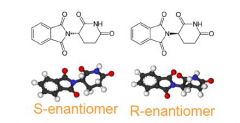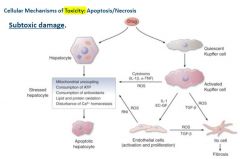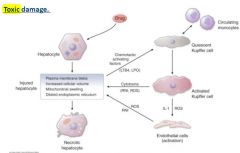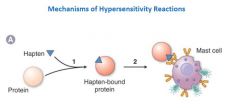![]()
![]()
![]()
Use LEFT and RIGHT arrow keys to navigate between flashcards;
Use UP and DOWN arrow keys to flip the card;
H to show hint;
A reads text to speech;
50 Cards in this Set
- Front
- Back
- 3rd side (hint)
|
Where can Toxicity result from?* |

Toxicity can result from: Unintended activation of inhibition of intended target (on-target adverse effects); or Unintended activation of inhibition of unintended target (off-target adverse effects). |
|
|
|
what is on-target effects? |
If a drug target is expressed in more than one cell type. |
|
|
|
what is the use of Diphenhydramine? |
Diphenhydramine is a H1receptor antagonist, used to mediate the effects of histamine release in allergic conditions. |
|
|
|
what are the adverse effects of Diphenhydramine? |
It can have adverse effects is it crosses the blood brain barrier and can affect the CNS. This lead to the development of terfenadine(2ndgen anti-histamine), which doesn’t cross the blood brain barrier, but does lead to off target effects by interacting with cardiac potassium channels increasing the chance of cardiac death!!!! |
|
|
|
what is Statinsare designed for? |
Statinsare designed to block HMG-CoA reductase in the liver. |
|
|
|
what is the rare adverse effect of Diphenhydramine?* |
A rare adverse affect is muscle toxicity and myositis, revealing a role for HMG-CoA reductase in regulating post translational modification of several muscle proteins. |
|
|
|
Inhibition of potassium current carried by Iκr channels (aka. hERGchannels) can lead to what? |
Inhibition of potassium current carried by Iκr channels (aka. hERGchannels) can lead to repolarization of cardiac myocytes. |
|
|
|
Delayed repolarization can lead to what? |
Delayed repolarization can lead to increased heart rate. |
|
|
|
example of Enantiomers of a drug |

Enantiomers of a drug. e.g. thalidomide. |
|
|
|
difference between r-enantiomer and s-enantiomer |
R-enantiomer is an effective sedative, the S-enantiomer is a potentmutagen/teratogen that causes serious birth defects, such as loss of limbs.
|
|
|
|
what happens If therapeutic Index (TI) is low ?* |
If therapeutic Index (TI) is low then toxicity may occur. |
|
|
|
Administration of a drug that inhibits or is a substrate for P-glycoprotein (Pgp) encoded by MDR1 gene, can lead to what? |
Administration of a drug that inhibits or is a substrate for P-glycoprotein (Pgp) encoded by MDR1 gene, can lead to increased plasma levels of drugs normallly exported by this mechanism. |
|
|
|
how can A pharmacokinetic effect can have positive effects?* |
A pharmacokinetic effect can have positive effects:
Penicillin half life can be increased by coadministration with probenecid, which inhibits renal tubullar transport .The other example given is the antibiotic imipenem, which is inhibited by dehydropeptidase I,with cilastatin, which is a selective inhibitor of dehydropeptidase I. |
|
|
|
what happens when antibiotic imipenem, which is inhibited by dehydropeptidase I,with cilastatin, which is a selective inhibitor of dehydropeptidase I?* |
antibiotic imipenem, which is inhibited by dehydropeptidase I,with cilastatin, which is a selective inhibitor of dehydropeptidase I, leads to therapeutic plasma levels o f imipenem. |
|
|
|
what happens when a drug that binds to plasma proteins may outcompete drugs that bind plasma proteins? |
Finally, a drug that binds to plasma proteins may outcompete drugs that bind plasma proteinsincreasing the bioavailability of a drug. |
|
|
|
How can the bio-availability of a drug be enhanced? |
This can be enhanced where circulating albumin is low, as occurs during liver failure ormalnutrition. |
|
|
|
when does Pharmacodynamic effects occur? |
Pharmacodynamic drug-drug interactionsPharmacodynamic effects can occur when one drug changes the response of a target (or nontarget) tissue to another drug. Two drugs activating complementary pathways leading to exaggerated effects. 1+1=3???? |
|
|
|
example of drugs where Pharmacodynamic effects occur? |
e.g. sildenafil (erectile dysfunction) and nitroglycerin (for angina) |
|
|
|
effect of sildenafil |
Sildenafil prolongs the action of cGMP, by inhibiting phosphodiesterase5 (PDE5), and nitroglycerin stimulates cGMPin vascular smooth muscle cells. |
|
|
|
Warfarin and heparin can synergize leading to?* |
Warfarin and heparin can synergize leading to bleeding. Supratherapeutic levels of anti-coagulation. |
|
|
|
Drug-Herb Interactions lead to? |
Rarely tested. Can lead to toxic effects. |
|
|
|
example of Drug-Herb Interactions (no. 1) |
e.g. gonkgo biloba inhibits platelet aggregation. If taken in conjunction with Non-steroidal anti-inflammatory drugs it can increase risk of bleeding. |
|
|
|
example of Drug-Herb Interactions (no. 2)* |
e.g.Echinacea contains alkaloids which may deplete hepatic glutathione stores, increasing risk of toxicity. |
|
|
|
example of Drug-Herb Interactions (no. 3)* |
e.g. St Johns wort may also lead to serotonergic syndrome when taken in conjunction with selective serotonin uptake inhibitors (SSRIs). |
|
|
|
Moderate doses of a potentially toxic drug activate what? |

Kupffer cells and are metabolized by hepatocytes. The resulting stress may be exacerbated by: reactive oxygen species (ROS) and reactive nitrogen intermediatesibrosis.ibrosis.De |
|
|
|
high doses of toxic drug can lead to? |

High doses of a toxic drug metabolized by hepatocytes can induce cell injury. |
|
|
|
Factors released by the injured hepatocytes activate? |
Kupffer cells and , endothelial cells, whichelaborate toxic ROS and RNI. |
|
|
|
what happens When a drug binds to a protein? |
Hapten it is then capable of eliciting an immune response >>Indirect. |
|
|
|
Direct induction of the immune system, can result in |
hypersensitivity & autoimmunity.>>direct. |
|
|
|
Type I hypersensitivity (aka intermediate). |
>Wheel and Flair in the skin, hay fever symptoms. |
|
|
|
Type II hypersensitivity (antibody dependent) |
>rare adverse responses (e.g. Penicillin) |
|
|
|
Type III hypersensitivity (immune complex mediated) |
>IgG& IgMcomplexes aggregate in tissues (e.g. lungs etc). >>>Serum sickness.Can be caused by administration of antivenins. |
|
|
|
Type IV hypersensitivity (delayed –type) |
>activation of cytotoxic t-cells.Repeated exposure following initial insult….can lead to the cytokine storm >>fever, hypertension, and even organ failure. |
|
|
|
explain the Mechanisms of Hypersensitivity Reactions |
...................................................... |
...................................................... |
|
|
A. Type I hypersensitivity reactions occur when (continued)..... |

a haptenbinds to a protein (1).The antigen crosslinks IgEantibodies on the surface of a mast cell, leading to mast cell degranulation (2). |
|
|
|
(continued)...... these Mast cells release what? |
Mast cells release histamine and other inflammatory mediators. |
|
|
|
B. Type II hypersensitivity reactions occur when (continued)...... |

an antigen binds to the surface of a circulating blood cell(1). |
|
|
|
(continued)..... Antibodies to the antigen then bind the surface of the RBC (2), attracting |
cytotoxic T cells (3), which release mediators that lyse the RBC. |
|
|
|
(continued)..... Binding of antibody to RBCs can also directly stimulate |
complement-mediated RBC lysisand RBC removal by the reticuloendothelialsystem. |
|
|
|
C. (continued)..... Type III hypersensitivity reactions occur when |

antibodies bind to a soluble toxin, acting as an antigen (1). |
|
|
|
(continued)..... The antigen–antibody complexes are then deposited in the tissues (2), attracting |
macrophages (3) and starting a complement-mediated reaction sequence (not shown). |
|
|
|
D. (continued)..... Type IV hypersensitivity reactions occur when |

a hapten binds to a protein (1) and the hapten- bound protein is phagocytosed by a Langerhans cell (2). |
|
|
|
(continued)..... The Langerhans cell migrates to a regional lymph node, where it |
presents the antigen to a T cell, thereby activating the T cell (3). |
|
|
|
Autoimmunity is |
(lack of self recognition) e.g. Methyldopa can cause haemolytic reactions by initiating autoimmunity against Rhesus antigens (Rh Factors)Some drugs can induce antibodies against myuelpoperoxidase(eg. Hydralazine) and even DNA (procainamide). |
|
|
|
Red man syndrome is |
(anaphylactoidshock) e.g. I.V. introduction of vancomycin. Direct effect on mast cells.Head neck and shoulders (upper trunk).Can be alleviated by use of antihistamines. |
|
|
|
Chemotherapies targeting cancer are designed for what? |
Designed to target proliferating cancer cells, also damage the bone marrow/ and bone marrow originating immune cells. |
|
|
|
Chemotherapies associated with? |
Associated with increased risk of infection. Various ways to stimulate leukocyte production such as filgrastin. |
|
|
|
Some therapies target specific cells Rituximab is a monoclonal antibody which targets |
CD20+ B-cells, which are important in lymphoma and arthritis. |
|
|
|
Chemotherapies can lead to? |

Can lead to opportunistic infections that rely on an immunocompromised patient. Another example is efalizumabwhich targets CD11a, blocking leukocyte adhesion. |
|
|
|
Drugs metabolized in the liver can produce |
toxic by-products damaging the liver. e.g. acetaminophen. |
|

